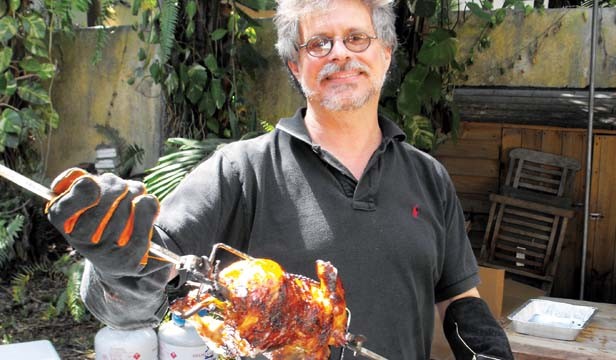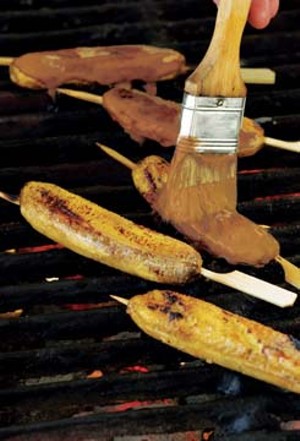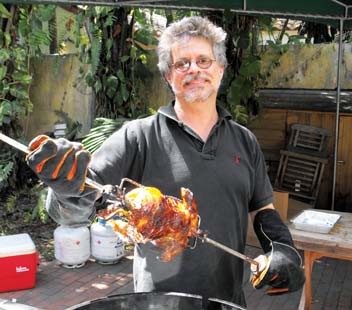
What picture pops into your head when you hear the words “barbeque expert”? Is it a big beefy guy, tongs in hand, maybe a bit red-faced from hovering over the coals and the beer can in his other hand; his ball cap and t-shirt or apron inscribed with the logo of his favorite barbeque competition, festival or sauce?
Steven Raichlen couldn’t be more different. Slight of build and slightly rumpled, bespectacled, with salt and pepper beard and thick curly hair, he looks more like an academic than a good-ole-boy. But his appearance is the least of the reasons he’s known as “The professor of barbeque,” that his first PBS cooking series was titled “Barbeque University,” or that millions of copies of his barbeque books have been sold and translated into 15 languages.
He sounds more like an academic, too, though not at all stuffy. Before a recent appearance in Chicago to promote his latest book, Planet Barbeque, Raichlen told me about his sideways journey into the world of barbeque: “I’d graduated from college with a degree in French literature – my senior thesis was on an obscure medieval French poet. And then I was lucky – I got a fellowship from the [IBM founder Thomas J.]Watson Foundation.”
Raichlen used the fellowship to study medieval cooking in France. Which, of course, was all done over live fire. “I became fascinated by the interface of food and culture,” he says. That fascination extended itself not just to medieval France, but also to the development of cooking over fire and how it has developed and is practiced all over the world.
Literally. In Planet Barbeque’s introduction, Raichlen says that “grilling over live fire is practiced 24-7 on all seven continents,” noting that even in Antarctica, Russian scientists recently braved double-digit below zero weather to grill pork shashlik (shish-kebabs).
He writes: “For some people (especially if they live in the southern half of the United States) barbeque means the low, slow, smoke roasting of [such things as] Texas brisket or North Carolina pork shoulder. For others…the vast majority of citizens of Planet Barbeque…the process involves direct grilling steaks, chops, kebabs, burgers, breads, vegetables and fruits quickly over a hot fire. . . . Thus, for practical purposes, [my definition of] barbeque embraces the ancient art of cooking with live fire, a specific cooking technique involving wood smoke, a series of iconic dishes, a meal prepared and eaten outdoors, and a communal food experience. When I say barbeque I mean…all of the above.”
In Chicago, “Professor” Raichlen delivered a lively and fascinating lecture on the evolution of barbeque and its influence on humans’ physical evolution (cooked food is easier to digest and metabolize as well as to eat, with consequently less time spent chewing, lead to smaller teeth and jaws, making the mouth and tongue more agile for speaking) as well as social evolution (shared communal activities of cooking, eating sitting and sleeping around a fire). He noted similarities between grilled stuffed egg preparations in medieval France and Cambodia and illustrated differences and similarities between barbeque methods and preparations around the globe. And he said that, unlike chefs [and passionate amateurs] “most barbeque folks in third world countries are pretty far down on the socio-economic scale. Every culture creates the kind of barbeque that fits its resources, customs, and so forth.” And most make fantastic barbeque without fancy/expensive equipment.
His audience couldn’t have been more enthusiastic. “You’ve changed my life,” said one. “You’ve given me a hobby as well as a passion.” Two high school teachers told Raichlen they’d used his books and techniques for their school’s Experience Week; having their students cook over live fire.
Raichlen’s vast – and truly encyclopedic – knowledge of global barbeque and its anthropology might have garnered attention from a few enthusiasts, but his true genius – and source of his popularity – lays with his having combined that knowledge with equal expertise in barbequing techniques, methods and equipment, and his teaching skills used for all of them. All his books on the subject, from his first, Barbeque! Bible, have included detailed techniques and steps (often with photo illustrations), as well as information about tools and equipment. In fact, his How to Grill, though it contains recipes, primarily deals with techniques and everything else needed to master the art of barbequing.
Raichlen spent five years, and traveled to 53 countries in six continents, researching for Planet Barbeque. It includes everything from a Colombian recipe for salt-crusted beef tenderloin wrapped in cheesecloth and roasted directly on embers (the dish he selected, when asked in Chicago, as the one above all others he’d recommend making) to Spanish grilled bread with chocolate, two Indian chicken tikkas, French mussels grilled on pine needles, Cambodian grilled chicken, and North Carolina pork shoulder. He discovers an unexpected grilling culture in Germany and lamb grilled on a shovel in Australia.
Planet Barbeque may be Raichlen’s last barbequing book. (He’s currently working on a novel dealing with the history of psychoanalysis.) He says that Planet Barbeque is, in a sense, a bookend. Barbeque! Bible, his first barbeque book, is also an exploration of barbequing worldwide, though without as extensive “how-to’s.” In between are BBQ USA (Raichlen calls it “an homage” to American barbeque) which is stylistically similar to Barbeque! Bible; and others such as How to Barbeque, Indoor Grilling, Raichlen on Ribs, and Beer Can Chicken.
Raichlen’s new PBS series, Primal Grill, can be seen currently on WSEC, Saturdays at 5:30 p.m. It will begin showing on WILL on July 24 at 2 p.m. Raichlen’s books, as well as lots of other barbequing paraphernalia, can be found on his website, http://www.barbecuebible.com/.
Contact Julianne Glatz at [email protected].
Grilled bananas with coconut-caramel sauce

Raichlen’s recipes come with provenance: stories of where they come from and how they got there. As often as not, those stories are as interesting and compelling as the recipes themselves. Here’s what he has to say about a Bangkok grill mistress, Saisuwan, and her specialty:
“Five years ago she scraped together enough cash to set up a pushcart….Her grilling skills became so legendary, guidebooks from all over the world sing her praises. Saisuwan serves just one dish – but what a dish – grilled bananas slathered with coconut caramel sauce. You can eat them for breakfast, as a snack, or for dessert, and the moment you finish, you’ll very likely find yourself returning for seconds. If you happen to find yourself near the Sheraton hotel in Bangkok, you’ll recognize Saisuwan by her trademark white cap and by the sweet scent of bananas grilling over coconut shell charcoal.”
For the coconut-caramel sauce:
- 1/2 c. palm sugar or light brown sugar
- 1 c. unsweetened coconut milk
- 4 bananas, slightly under-ripe
Set up the grill for direct grilling (placing the bananas directly over the coals) and prepare/preheat a hot fire.
Brush and oil the grill grate. Peel the bananas and skewer them through on end if desired. Grill the bananas until they are lightly browned and partially cooked, 1-2 minutes per side. Dip the bananas in the coconut-caramel sauce (that’s where the skewer comes in handy) or brush the bananas on all sides, using a basting brush, and return them to the grill. Continue grilling the bananas until they are darkly browned and sizzling, 1-3 minutes longer per side. Use a bamboo skewer to test for doneness; it should easily pierce the banana. Transfer to plates or bowls. Spoon the remaining sauce on top and serve immediately. Serves 4

Pollo al mattone
(Tuscan-Style Chicken Under a Brick)
-
3 garlic cloves
2 T. stemmed fresh rosemary leaves - 2 T. stemmed fresh sage leaves
- 2 tsp. freshly ground black pepper
- ½ c. coarse salt (Kosher or sea)
- 4 whole baby chickens, poussins, or game hens (each 1 – 1 ¼ lbs.)
- OR 2 whole chickens (each 3 ½ - 4 lbs.)
- About ½ c. best quality extra-virgin olive oil, for serving
- 2 lemons, cut into wedges for serving
- Rosemary branches and sage leaves for garnish, optional
- 2-4 bricks wrapped in aluminum foil, or metal grill presses
Remove and discard the fat just inside the neck and body cavities of the chickens. Rinse inside and out and pat dry. Spatchcock the chickens (see instructions below). Generously season the birds on both sides with the herbed salt.
To grill: The direct grilling method is traditional, but using the indirect method produces a crisp, moist bird without the risks of flare-ups or burning.
The direct method: Set up the grill for direct grilling (the chickens will be placed directly over the coals) and prepare/preheat the coals to medium. Leave one section of the grill bare for a safety zone. Brush and oil the grill grate. Arrange the birds skin side down on the hot grate at a diagonal to the bars. Place the bricks or grill presses on top of the birds.
Grill the chickens until they are crisp and golden brown on the bottom, 8-12 minutes per side for the small birds, 12-20 for full-size chickens. Use an instant-read thermometer to test for doneness, inserting it into the thickest part of the thigh without touching a bone. The internal temperature should be about 170ºF. Give each bird a quarter turn after four minutes on each side to create handsome crosshatch grill marks.
The indirect method: Set up the grill for indirect grilling (The coals should be pushed to the sides of the grill, leaving the center empty.) Place a drip pan in the center and prepare/preheat the coals to medium. Arrange the birds skin-side up in the center of the grate over the drip pan and away from the heat and place the weights on top. Cover the grill and cook until golden brown and cooked through, turning once, 30-40 minutes for small birds and 40 minutes-1 hour for full-size chickens.
Serve generously drizzled with olive oil and garnished with lemon wedges and rosemary branches and sage leaves if desired.
To Spatchcock a Chicken:
Turn the chicken breast-side down. Using poultry shears, sturdy kitchen scissors, or a sharp knife and starting at the neck end, make two lengthwise cuts along the backbone, one on each side, from the neck to the tail.
Cut out the backbone and save it for making stock, or discard.
Open the chicken up like a book. Run the tip of a paring knife along the breastbone and cartilage below the breastbone.
Run your thumbs along both sides of the breastbone and white cartilage, then pull them out.
Using a paring knife, cut a 1-inch slit in the skin between each leg and the back end (bottom) of the breast.
Insert the knob end of each drumstick through the hole closest to it, so that the chicken lays flat.
Tuck the wingtips behind the wings or cut them off and add them to the backbone for stock.















